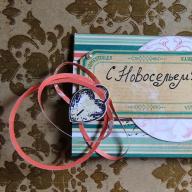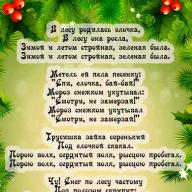These funny house slippers are knitted with crocheted details. In such home shoes your feet will be warm both in autumn and winter.
Size of knitted slippers: 35-36
For knitting, you will need: yarn (50% wool, 50% acrylic, 300 m / 100 g) - 60 g dark brown, Carolina yarn (100% acrylic, 438 m / 100 g) - black residues, yarn "Grass" (100% acrylic) - remnants of light brown and dark brown colors, needles No. 2.5, hook No. 2.75, synthetic winterizer.
Garter stitch: persons. and out. the ranks are only persons. loops.
Elastic band 1x1: knit 1 person alternately. n. and 1 n. P.
Knitting density: 18 stitches x 30 rows of garter stitch = 10 x 10 cm.
How to knit slippers. Description of work and knitting patterns.
Start knitting from the sole. On knitting needles with a dark brown thread in 2 additions, dial 26 stitches and knit with garter stitch, adding on both sides in each 2nd row 6 times x 1 st. = 38 stitches.Then knit 4 rows without additions, then subtract from both sides in each 2nd row 6 times x 1 p. = 26 p. Next, knit the upper part. To do this, dial an additional 7 points on the knitting needle (continuation of the sole), turn the work. Knit the resulting 33 sts, at the end of the row add 1 more st. Then from this edge add 5 more times x 1 sts in each 2nd row (as on the sole of the slippers). Work 12 rows straight. Then close 20 stitches from the heel side, knit the remaining loops with garter stitch for 6 more rows straight. Then start decreasing from the toe side in each 2nd row 6 times x 1 st. After that, from the heel side, dial 20 stitches again and knit 12 more rows with 1x1 elastic. Close the hinges. Sew a seam.
Ears: crochet the slippers with 5 rows of st. b / n. In the next row, knitting the side part and reaching the fold line, add 1 brown thread and knit the eyelet with b / n columns according to the pattern. After knitting 10 rows with half-columns, return to the front of the product, knit 3 tbsp. b / n and perform the second ear in the same way. Then tie the ears and side part 1 next to st. b / n thread "Grass" of light brown color.
Muzzle: with Carolina thread in 2 additions, cast on 16 stitches, knit 2 rows straight with garter stitch needles. Then add on both sides in each 2nd row 2 times x 1 st. = 20 sts. Knit 18 rows without additions, then subtract from both sides in each 2nd row 4 times x 1 st. close the hinges. Tie the piece around the entire perimeter 1 next to Art. b / n. Then knit 1 more row of st. b / n, skipping every 2nd st. the previous row so that the muzzle tightens.
Spout: with black thread in 2 additions, cast on a chain of 3 air. etc., close in a ring. Knit 6 tbsp. b / n in the ring. Next, knit in a circle with columns b / n, evenly adding 6 tbsp. in each row. When you get a circle with a diameter of 3 cm, pull the part along the edges, stuffing with padding polyester.
Assembling the details of knitted slippers: sew the muzzle with a narrow part between the ears, lightly filling with padding polyester. Fill the wide part with padding polyester, sew on. Sew the nose onto the muzzle. Sew on or glue on the eyes.
It's no secret that small decorative dogs need shoes, not only for a walk, but at home too. At home, of course, it is not as cold as outside, but the dog will be much warmer and more comfortable in the slippers. A small decorative dog in such slippers will feel just great and cozy. How to knit slippers for dogs will be discussed below.
You will need:
thirty grams of colored and ten grams of black yarn (two hundred and fifty meters / one hundred grams) for a sole size of four by five centimeters,
four knitting needles (no. 2.5), a sewing needle;
1m satin ribbon, rubber thread.
How to knit dog slippers:
Let's knit a pattern of slippers for dogs. In order to determine the knitting density - we type twenty-four loops on the knitting needles and knit with an elastic band one by one thirty rows, the canvas should come out measuring ten by ten centimeters. We collect eighteen loops with a double thread and knit thirty-two rows, the canvas - ten by ten centimeters.
We measure the length as well as the width of the sole (here - five centimeters or sixteen rows, four centimeters or seven loops),
the height of the toe of the slippers (one and a half centimeters or four rows),
the height of the slippers (four centimeters or twelve rows),
along the upper edge of the slippers - the girth of the foot (twelve centimeters or thirty-six loops),
the distance from the toe to the bootleg (two centimeters or six rows).
We start knitting a slipper for dogs from the sole, it is done with garter stitch. We collect seven loops in two strands of black yarn and perform two rows, in the third, we add one loop on each side, then we continue the canvas to the sixteenth row. In the sixteenth row from each, we knit two loops together and in the next, close the loops.
You need to knit the bootleg of the slippers. We knit the first 2 rows with garter stitch needles. We collect along the edge of the sole of the slipper with colored thread on the first and third knitting needles, six loops each (heel and toe), eight loops each - on the second and fourth (side parts). In the second row we knit a heel and a toe of a slipper, add three loops each, add four loops to the side parts.
Next, you need to knit with an elastic band one by one four rows (sock height). Then we make the front part of the dog slippers. On the knitting needle where the sock loops are, we knit six rows in garter stitch (the distance from the toe to the bootleg). On the “toe” knitting needle, we knit each last loop together with the first loop from the knitting needle of the side part (the first row - front, the second row - purl) and leave it on the “toe” knitting needle, then turn the knitting.
We continue to knit the bootleg of a slipper on four knitting needles (each has nine loops after making a sock) with an elastic band one by one for eight more rows, and close the loops. So that the slippers do not fall off, we quilt the bootleg with a rubber thread. Cut the satin ribbon in half and sew it on the middle on the back of the bootleg.
A master class on crocheting home slippers.
By size - 36-38.
Sole length ready-made slippers- 26 cm.
Yarn consumption- 170g.
Materials:
- Pekhorka Autumn yarn (25% wool, 75 PAN volumetric 200g / 150m)
- hook number 6.5;
- black yarn near Moscow for the nose and embroidery;
- felt black and white;
- two black buttons with a diameter of 18 mm;
- white threads;
- needle;
- synthetic fluff in the nose;
- felt sole.
The yarn is very thick, so I would advise you to take even more crochet hook than mine. At the time of knitting, my largest was only 6.5.
Description of knitting slippers
The schemes are all manually, as they were invented-knitted-dismissed on the go :)
Sole
We knit the sole according to the scheme below, if you need a larger size, then increase the number of air loops in the typesetting chain. I have 12 air items.
As a result, the slippers turned out to be wide, but this is also because I stretched them along the width of the sole. You can also climb in with a woolen sock :)

Pattern for knitting soles:
+
- these are single crochet; with a stick at the top- this is half. with one crochet.
Knit 3 rows according to the pattern.
4th p .: tie according to the picture. Set aside, do not cut the thread.
Unstretched length about 24 cm.

Slipper top
The upper part consists of 15 rows, knit according to the pattern below.

Pattern for knitting the top of the sneaker:
Attention! 5, 6 rows are not indicated in the diagram - we knit 14 st.
and 9, 10 rows - we knit 12 st.

We put the upper part on the sole, determine the beginning of sewing.
We connect by knitting 1 row of Art. b / n. On the sole diagram, this is the 5th row. Increases in this row are indicated on the side - 3 columns are obtained on the heel and toe.
6th p .: rachiy step.



Ready! cut off the threads, hide. Also, if you are "worried" about the holes in the middle of the sole, you can tighten them with a thread thinner with the help of a needle.

Ears (4 pcs.)
8 rows according to the scheme, 9th p. - the step of a man.
Then I sewed it on with threads.



Eyes
Black ovals are about 4-5 cm. Cut out 4 black and 4 white ovals.
I put white on black with a shift to the middle, sewed on the buttons. Then I sewed the white circles with a seam "forward needle".

Then along the black oval to the sneakers.
I sewed on the ears, bending it in half.


Nose
Hook number 3. 3 vp into the ring.
1 p .: 10 tbsp. b / n .; 2 p.: 20 Art. b / n; 3 r .: 30 Art. b / n; 4, 5 p .: 30 item b / n.
Fold to the bottom with a corner, fill a little with padding polyester and sew on the muzzle.
Embroider the mouth.
All the muzzle is ready.


You can always buy beautiful shoes at your nearest pet store. But will they be comfortable? When making shoes for a dog with your own hands, it is not difficult to take into account all the anatomical features - the set and size of the paws, the angle of rise, the ideal height of the bootleg. And the most pleasant thing is that it is not difficult to sew or knit boots for a four-footed friend.
Before we start cutting out and sewing, let's remember the important nuances:
- it is clear that since a dog has four paws, it should also have four boots. But shoes should be sewn in pairs: the hind and front paws differ in the size of the feet, the rise, the distance from the foot to the joint. You need to measure two legs - front and back separately;
- the boots should not slip, so the material for the outer part of the sole should be rough. You can sew a Velcro strip to the sole, but it will collect dust and fine debris;
- Shoes should in no case be tight, so you need to sew with a small margin for the movement of the paw back and forth when walking. Consider the length of the claws and the fact that the toes are spread out and protrude forward when the dog rests on the foot with all its weight. To make the pattern of shoes for dogs accurate, measure the paw in a rack - the pet rests completely on the limb, does not squat when measuring the front foot and does not lean forward when you touch the hind paw;
- something tightening is more convenient as a fastener, rather than a zipper or buttons. It is important that the fastener (elastic band, Velcro, braid on the retainer) does not squeeze the limb and does not interfere with the bending of the joints when walking. Poor circulation in the paws quickly leads to hypothermia! In addition, the dog will probably try to take off such a boot;
- so that the shoes do not chafe, it is better to make the seams outside. Especially if it is a winter model made of dense tanned fabric, fur, dense leather. Rough outer seams can be hidden under tape, piping, or decorative overlock seams.
When walking, dogs lean on their toes, and not on the whole foot, like a person. For them, the comfort of the shoe is extremely important - the changed position of the paws quickly leads to chronic diseases of the joints. Therefore, first of all, always think about comfort, and only then about beauty. A dog in shoes should walk the same way as without it - stepping confidently, not seeding. The boots will have to be redone if the pet's paws move to the sides, the shoes fall off, the sole is clearly not under the foot, the socks look anywhere but forward.
If you urgently need to sew protective shoes for dogs of large breeds with your own hands, this option is ideal (the dog cut his paw, but there is no "rescue" shoe). For long-term wear, such shoes are not very suitable. For small dogs and pets with lean, lean paws, a few extra stitches are required. The material needs soft, elastic and waterproof. The sole can be reinforced by sewing on a piece of thick, non-slip fabric on the outside.
So, the inner oval or circle is equal to the outlines of the foot (you need to measure the length and width). Line CD is the desired boot height.

- cut out a circle / oval from the fabric, as it turned out by the measurements and a couple of cm for the hem on top;
- we put the dog's paw in the center, right on the fabric;
- lift the fabric up, covering the foot and metacarpus (as if packing a flower pot);
- we make several tucks with pins, collecting excess fabric into darts (all unnecessary - outside the boot). Keep in mind that the boot must be worn freely, i.e. it is not necessary to tighten the width too much with darts;
- inside, you can sew a dense felt insole or sew on the sole from the outside. You can leave the boot soft, but the fabric must be waterproof;
- we sew along the line of the darts, cut off the excess protruding fabric;
- tuck the top and skip the rubber band or cord on the retainer. We do the same tightening around the pastern, just above the foot.
Read also: Stunt dog training
Comfortable two-piece boots
This shoe pattern for small dogs is suitable both as a base for winter boots and for sewing light raincoats or anthers. Boots sit comfortably enough on the paw if the fabric is dense and keeps its shape. The insole and / or sole can be reinforced as you wish - with dense leather, a piece of tanned leather, felt or left soft. Lightweight boots for protection from moisture and dust are sewn in literally half an hour, winter boots made of fur or leather take a little longer - you need an awl to make punctures, and strong threads.

- draw the sole according to the measurements of the foot plus seam allowances;
- draw a trapezoid, the height of which is equal to the height of the boot, and the width is equal to the girth of the pastern. At the bottom of the trapezoid there is a wave, as in the figure. Its rise will be at the back, on the heel (the narrowest point of the trapezoid is the back of the boot), and the sharp angle will be on the toe of the boot. We are looking for the shape of the wave approximately - it is convenient to cover the foot with paper or an unnecessary piece of fabric, estimate the bends and mark them with chalk / felt-tip pen. And then from the "draft" transfer the pattern to the fabric.
- we process the top (in the photo on the top there is a checkered decorative edging, but it is better to put in an additional loose elastic band);
- fold the trapezoid in half, try on the sole. The seam that connects the sides of the trapezoid must match the toe of the boot, i.e. bump into it. The fold will be in the back, behind the heel. Sew on the part to the sole;
- now we sew the trapezoid along the lines (orange in the picture). The back turns out to be vertical, and the front part is slightly beveled due to the inclination of the sides of the trapezoid. If there is a lot of excess fabric, you can make a dart in front just above the foot (see number 1 in the photo). Around the metacarpus, just above the joint, we skip a lace or Velcro tape (number 2 in the photo).
Boots with tongues
Part 1 - the side of the boot, you need two for one boot (or four if you want to insert a lining of fleece or other warm material). The tongue is approximately equal in length to detail 1, i.e. the height of the boot. The sole is along the contour of the foot (detail 3). Detail 4 covers the toe and, together with the tongue, forms the front of the boot (you can see how the sneakers are sewn - it will become clearer). To sew comfortable shoes for small breed dogs with your own hands according to the pattern below, you will have to do a few trial fittings. Use paper or waste fabric for rough fittings.

- Sew together the heels of the sidewalls and sew along the oval to the sole, starting from the back of the boot. While we sew to the middle of the sole;
- we sew the tongue and toe;
- sew the toe to the front of the sole;
- we sew the sides to the end, connect them to the toe. The tongue remains free, the side parts do not need to be sewn along the tongue to the very top, otherwise it will be difficult to pull the boot over the paw;
- it remains to pass a lace or Velcro tape around the pastern. If the boots are high, you need an extra elastic band or another drawstring on top. If you are sewing shoes for a large dog, you can insert a strip of fabric between the sides and the sole, the width of which corresponds to the height of the foot from the floor to the beginning of the joint (see the following pattern, this strip is used there).
Read also: Darling dog food
Comfortable boots for any weather
If you sew from dense leather with a lining, you get warm winter boots with a high shaft. But the pattern is also suitable for sewing nylon raincoats.

Compare the picture with the photo below - it will become clearer what's what. Detail 1 - sole with a slightly cut heel (the heel is not rounded, but almost straight). Detail 2 - the top of the boot, covering the foot to the beginning of the metacarpus (to the point where the bootleg begins, i.e. the top completely). Detail 3 gives additional space inside the boot - its width is equal to the height of the foot from the floor to the joint, and its length is equal to the circumference of the sole. Cylinder-folded part 4 - boot (the height is at your discretion, but low boots hold up worse).
- we sew a strip (detail 3 in the figure and in the photo) to the sole (1), in a circle;
- sew the upper part of the boot (2) to the strip in front, not completely;
- the bootleg (part 4) remains open, not stitched. Sew the bottom of the bootleg (back fold) to the strip behind the heel and to the top of the boot in front. The edges of the bootleg remain free, open - so it is more convenient to put on and take off your shoes. To prevent the paws from getting wet and freezing, on one side of the bootleg, you need to sew a shelf (5 in the figure) - a strip of fabric, as if under a zipper on trousers.
- Trying on the boot and finding a spot just above the joint, just above the foot. Here you need to sew a pair of drawstrings (loops of fabric strips) to the bootleg, through which the Velcro tape will pass. We simply wrap the tape around the pastern and tighten it a little (so that the boot does not fall off, but also does not squeeze the paw). If you make two rows of Velcro, the dog will gladly splash in the mud, not noticing the bad weather: such shoes do not slip, do not twist and do not change their paws.





